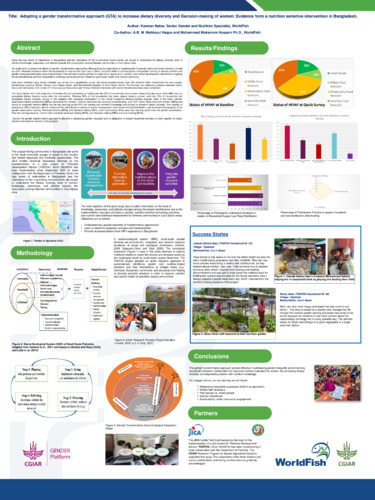Adopting a gender-transformative approach (GTA) to increase dietary diversity and decision-making of women: Evidence from a nutrition-sensitive intervention in Bangladesh
Abstract
Given the high levels of malnutrition in Bangladesh, and the importance of fish in providing micronutrients, we sought to understand the dietary diversity, level of nutrition knowledge, awareness and attitude toward fish consumption among fisheries communities in the Cox’s Bazar area. In addition, the study aims to assess the effects of gender-transformative approaches (recognizing the importance of targeting both husbands (men) and wives (women). The study also targets other influential members within the households to improve the food, nutrition and build skills in communication and problem-solving to discuss nutrition and genderrelated problems that were implemented in the technical training portfolio for agriculture, aquaculture, nutrition, and market development interventions. The study aims to assess the effects of gendertransformative approaches to discussing nutrition- and gender-related problems that were implemented in the technical training portfolio for agriculture, aquaculture, nutrition and market development interventions targeting female beneficiaries and their husbands to challenge gendered barriers to agriculture, health and nutrition behaviors. Data were collected using mixed methods; we carried out quantitative survey from 322 artisanal fisher households (project beneficiaries) of Cox’s Bazar district. We collected qualitative (semistructured interviews), 16 focus group discussions and 16 key informant interviews. The result shows that the proportion of women who are consuming an inadequate diet was 55% of households that have a lower dietary diversity score, while 45% have an acceptable dietary diversity score after the intervention. Whereas 82% of the households had lower dietary diversity scores, and only 18% of households had acceptable dietary diversity scores at the baseline with increased participation in the critical household decision-making process. The basic nutrition- awareness training participants (92%) understood topics. Nutrition (92%) and caring for pregnant mothers (84%) and women’s knowledge contributed to women’s dietary diversity. The majority of participants (92%) understood the topics of the gender sensitization training: workload sharing (94%), joint decision-making (66%), and trust building (64%). Most participants practised workload sharing (91%), joint decision-making (70%) and trust building (61%). Overall, the gender-transformative approach is effective in addressing gender inequality and its adaptation to enable household members to work together for better nutrition outcomes for women in this program.

